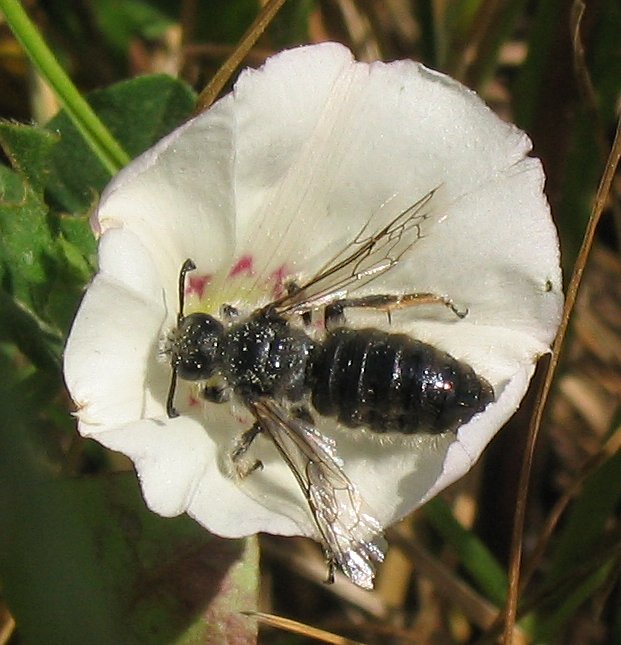|
Systropha
The genus ''Systropha'' comprises several species of Old World sweat bees, primarily specialist pollinators of plants in the genus '' Convolvulus''. Males of the genus have unusual curled antennae, and females have pollen-carrying hairs covering almost the entire abdomen. Michener, C.D. (2000). ''The Bees of the World''. Johns Hopkins University Press Distribution ''Systropha'' species occur from Spain and Morocco east to Tajikistan, and north as far as southern Germany. They occur in both eastern and western parts of Africa, south to Namibia. Asian species range as far south as Sri Lanka and Thailand. Life history So far as is known, all species are oligolectic on flowers of '' Convolvulus'', with unusual modifications of the scopa, such that almost the entire abdomen (including the dorsal surface) is used for carrying pollen, rather than the legs, as in most bees. Pollen is carried to nests in the ground, formed into pollen masses, on each of which a single egg is laid before ... [...More Info...] [...Related Items...] OR: [Wikipedia] [Google] [Baidu] |
Halictidae
Halictidae is the second-largest family of bees (clade Anthophila) with nearly 4,500 species. Halictid species are an extremely diverse group that can vary greatly in appearance. These bees occur all over the world and are found on every continent except Antarctica. Usually dark-colored (frequently brown or black) and often metallic, halictids are found in various sizes, colors and patterns. Several species are all or partly green and a few are red, purple, or blue. A number of them have yellow markings, especially the males, which commonly have yellow faces, a pattern widespread among the various families of bees. The family is one of many with short tongues and is best distinguished by the arcuate (strongly curved) basal vein found on the wing. Females in this family tend to be larger than the males. They are commonly referred to as "sweat bees" (especially the smaller species), as they are often attracted to perspiration. Ecology Most halictids nest in the ground, often in ... [...More Info...] [...Related Items...] OR: [Wikipedia] [Google] [Baidu] |
Rophitinae
Rophitinae is a subfamily of sweat bees in the family Halictidae. There are about 13 genera and more than 260 described species in Rophitinae. Genera These 13 genera belong to the subfamily Rophitinae: * '' Ceblurgus'' Urban & Moure, 1993 * ''Conanthalictus'' Cockerell, 1901 * ''Dufourea'' Lepeletier, 1841 * '' Goeletapis'' Rozen, 1997 * ''Micralictoides'' Timberlake, 1939 * '' Morawitzella'' Popov, 1957 * '' Morawitzia'' Friese, 1902 * '' Penapis'' Michener, 1965 * ''Protodufourea'' Timberlake, 1955 * ''Rophites'' Spinola, 1808 * ''Sphecodosoma'' Crawford, 1907 * ''Systropha The genus ''Systropha'' comprises several species of Old World sweat bees, primarily specialist pollinators of plants in the genus '' Convolvulus''. Males of the genus have unusual curled antennae, and females have pollen-carrying hairs covering ...'' Illiger, 1806 * '' Xeralictus'' Cockerell, 1927 References Further reading * External links * Halictidae Articles created by Qbugbot ... [...More Info...] [...Related Items...] OR: [Wikipedia] [Google] [Baidu] |
Oligolecty
The term oligolecty is used in pollination ecology to refer to bees that exhibit a narrow, specialized preference for pollen sources, typically to a single family or genus of flowering plants. The preference may occasionally extend broadly to multiple genera within a single plant family, or be as narrow as a single plant species. When the choice is very narrow, the term ''monolecty'' is sometimes used, originally meaning a single plant species but recently broadened to include examples where the host plants are related members of a single genus. The opposite term is '' polylectic'' and refers to species that collect pollen from a wide range of species. The most familiar example of a polylectic species is the domestic honey bee. Oligolectic pollinators are often called oligoleges or simply specialist pollinators, and this behavior is especially common in the bee families Andrenidae and Halictidae, though there are thousands of species in hundreds of genera, in essentially all known ... [...More Info...] [...Related Items...] OR: [Wikipedia] [Google] [Baidu] |

